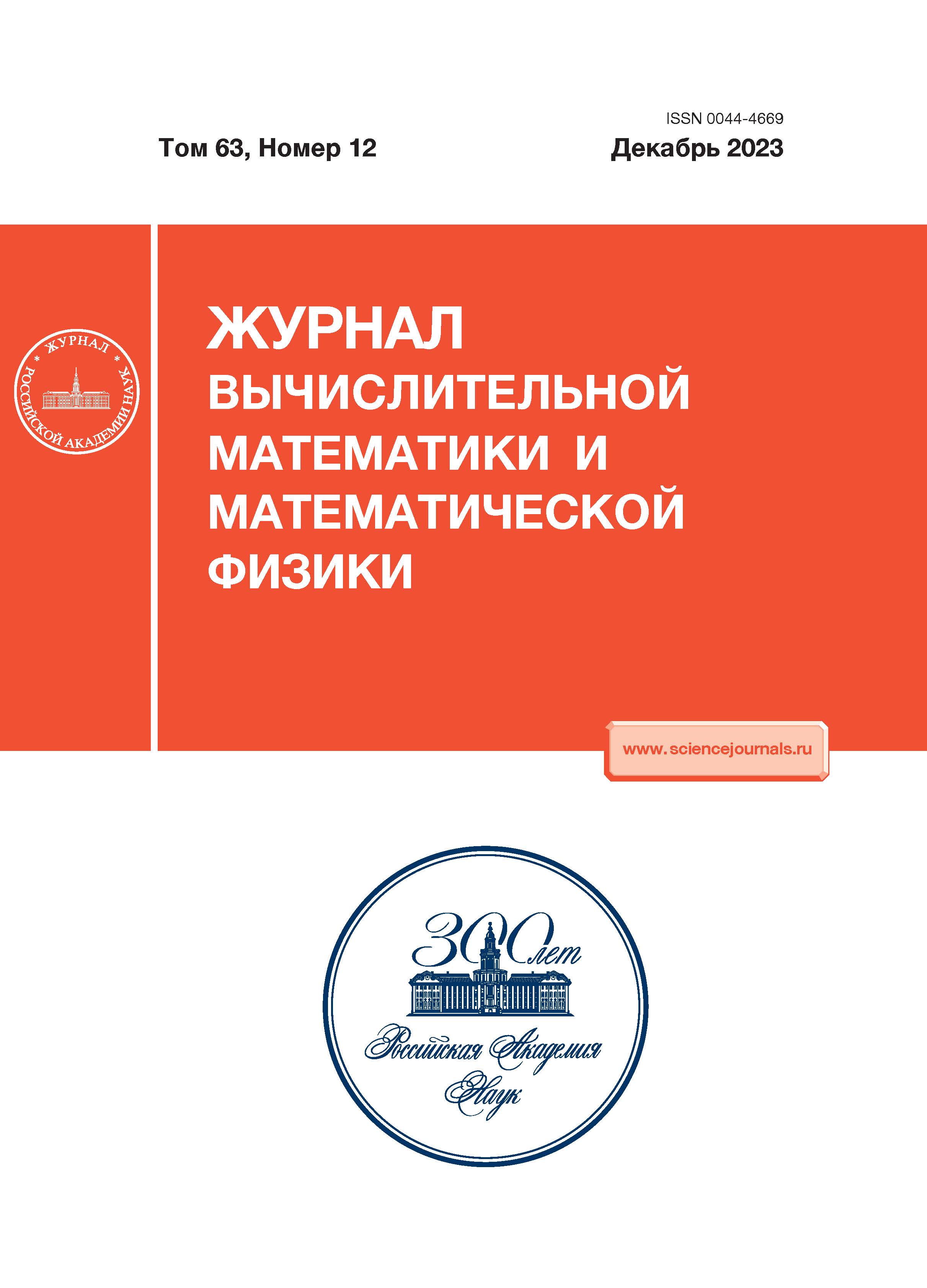Three-Dimensional Simulation of a High-Velocity Body Motion in a Tube with Rarefied Gas
- Authors: Yakunchikov A.N.1, Iuldasheva A.R.1
-
Affiliations:
- Faculty of Mechanics and Mathematics, Moscow State University
- Issue: Vol 63, No 12 (2023)
- Pages: 2051-2065
- Section: МАТЕМАТИЧЕСКАЯ ФИЗИКА
- URL: https://journals.rcsi.science/0044-4669/article/view/233034
- DOI: https://doi.org/10.31857/S0044466923120293
- EDN: https://elibrary.ru/JKTTGR
- ID: 233034
Cite item
Abstract
Flow around a body moving at a high subsonic velocity in a tube filled with rarefied gas is studied. This aerodynamic problem is considered as applied to the task of designing a high-speed vacuum transport at finite Knudsen numbers. Parameters that are close to target characteristics of such systems are chosen, more precisely, speed of about 1000 km/h, significant transverse size of the body, and nitrogen–oxygen mixture (air) as the filling gas are chosen. The problem was solved in a three-dimensional statement.
About the authors
A. N. Yakunchikov
Faculty of Mechanics and Mathematics, Moscow State University
Email: art-ya@mail.ru
119991, Moscow, Russia
A. R. Iuldasheva
Faculty of Mechanics and Mathematics, Moscow State University
Author for correspondence.
Email: a.r.iuldasheva@gmail.com
119991, Moscow, Russia
References
- Вейнберг Б.П. Движение без трения. СПб.: Естествоиспытатель, 1914.
- Musk E. Hyperloop Alpha Documents; SapceX: Hawthorne, CA, USA, 2013.
- Hyperloop One Website, https://hyperloop-one.com/.
- Hyperloop Transportation Technologies Website, https://www.hyperlooptt.com/.
- Kim H., Oh S. Shape optimization of a hyperloop pod’s head and tail using a multi-resolution morphing method// Int. J. Mech. Sci. 2022. V. 223. P. 107227.
- Sui Y. et al. An aerothermal study of influence of blockage ratio on a supersonic tube train system// J. Therm. Sci. 2020. V. 1–12.
- Chen X. et al. Aerodynamic simulation of evacuated tube maglev trains with different streamlined designs, J. Modern Transp. 2012. V. 20. № 2. P. 115–120.
- Zhou P., Zhang J., Li T. Effects of blocking ratio and Mach number on aerodynamic characteristics of the evacuated tube train// Int. J. Rail Transport. 2020. V. 8. № 1. P. 27–44.
- Oh J.-S. et al. Numerical Analysis of Aerodynamic Characteristics of Hyperloop System// Energies .2019.V. 12. № 3. P. 518.
- Sui Y., Niu J., Ricco P., Yuan Y., Yu Q., Cao X., Yang X. Impact of vacuum degree on the aerodynamics of a high-speed train capsule running in a tube // Int. J. Heat Fluid Flow. 2022. V. 88. P. 108752.
- Lluesma-Rodríguez F., González T., Hoyas S. CFD simulation of a hyperloop capsule inside a closed environment// Results Engng. 2021. V. 9. P. 100196.
- Le T.T.G. et al. Numerical investigation of aerodynamic drag and pressure waves in hyperloop systems// Mathematics. 2020. V. 8. № 11.
- Deng Z., Zhang W., Zheng J., Wang B., Ren Y., Zheng X., Zhang J. A high-temperature superconducting maglev-evacuated tube transport (HTS Maglev-ETT) test system // IEEE Trans. Appl. Supercond. 2017. V. 27. № 6. P. 1–8.
- Hruschka R., Klatt D. In-pipe aerodynamic characteristics of a projectile in comparison with free flight for transonic Mach numbers, Shock Waves. 2019. V. 29. № 2. P. 297–306.
- Seo Y., Cho M., Kim D.H., Lee T., Ryu J., Lee C. Experimental analysis of aerodynamic characteristics in the Hyperloop system, Aerosp. Sci. Technol., 2023. V. 137. P. 108265.
- Donev A., Garcia A.L., Alder B.J. Stochastic Event-Driven Molecular Dynamics // J. Comput. Phys. 2008. V. 227. P. 2644–2665.
- Valentini P., Schwartzentruber T.E. A combined Event-Driven/Time-Driven molecular dynamics algorithm for the simulation of shock waves in rarefied gases // J. Comput. Phys. 2009. V. 228. P. 8766–8778.
- Bannerman M.N., Sargant R., Lue L., Dynam O. A free O(N) general event-driven molecular-dynamics simulator // J. Comput. Chem. 2011. V. 32. P. 3329–3338.
- Akkaya V.R., Kandemir I. Event-driven molecular dynamics simulation of hard-sphere gas flows in microchannels // Math. Probl. Eng. 2015. № 2015.
- Yakunchikov A., Kosyanchuk V. Application of event-driven molecular dynamics approach to rarefied gas dynamics problems // Comput. Fluids. 2018. V. 170. P. 121–127.
- Yakunchikov A., Kosyanchuk V. Numerical investigation of gas separation in the system of filaments with different temperatures // Int. J. Heat Mass Transf. V. 138. P. 144–151.
- Yakunchikov A., Kosyanchuk V. A new principle of separation of gas mixtures in non-stationary transitional flows // Acta Astronaut. 2019.
- Artem Yakunchikov. The outflow of gas mixture into vacuum, periodically interrupted by bodies moving towards the jet // Vacuum Volume 209, March 2023, 111778.
- Yakunchikov Artem. Heat transfer in a rarefied gas between profiled surfaces moving relative to each other // International Journal of Heat and Mass Transfer Volume 184, March 2022. V. 122339.
- Yakunchikov A., Kosyanchuk V., Iuldasheva A. Rotational relaxation model for nitrogen and its application in free jet expansion problem, Phys. Fluids. 2020. V. 32. P. 102006.
- Marrone P.V. Temperature and Density Measurements in Free Jets and Shock Waves // Phys. Fluids. 1967. V. 10. P. 521.
- Mori H., Niimi T., Akiyama I., Tsuzuki T. Experimental detection of rotational non-Boltzmann distribution in supersonic free molecular nitrogen flows // Phys. Fluids. 2005. V. 17. P. 117103.
- Valentini P., Zhang C. and Schwartzentruber T.E. Molecular dynamics simulation of rotational relaxation in nitrogen: Implications for rotational collision number models // Phys. Fluids. 2012. V. 24. P. 106101.
- Tokumasu T. and Matsumoto Y. Dynamic molecular collision (DMC) model for rarefied gas flow simulations by the DSMC method // Phys. Fluids. 1999. V. 11. P. 1907–20.
- Реализация микроскопической модели столкновений для воздуха, https://multiscale.ru/science/collisionmodel.
- Miller S., Luding S. Event-driven molecular dynamics in parallel // J Comput Phys 2004. V. 193. P. 306–16.
Supplementary files















